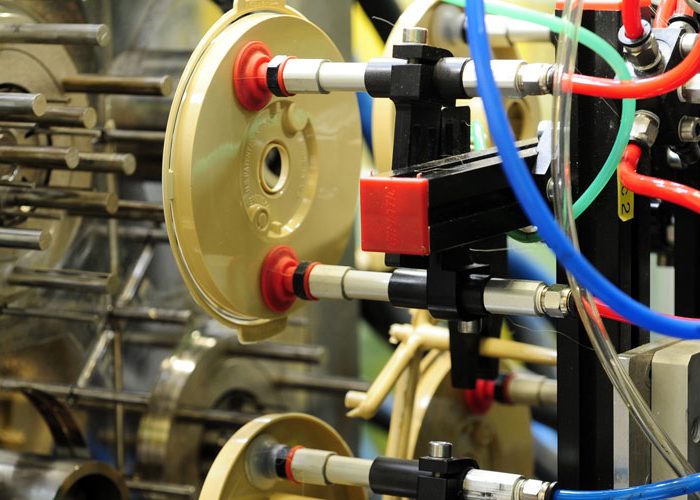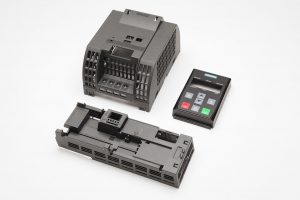Ever wondered how the countless plastic parts in your everyday life are made? From your phone case to your car’s dashboard, plastic injection moulding is a powerful manufacturing process that shapes molten plastic into precise and consistent end products.
In this guide we’ll dive into the world of injection moulding and explain:
- What it is and how it works
- The benefits it offers
- The wide range of applications


What is Injection Moulding?
Injection moulding takes plastic pellets and transforms them into solid plastic products using a specialised injection moulding machine. The plastic injection moulding process is broken down into the following steps:
Thermoplastic Material Selection
The process starts with choosing the right plastic type (resin) based on factors like strength, flexibility, and heat resistance.
Melting and Injection
The chosen plastic resin is melted until it becomes mouldable. Then, it’s injected into a precisely designed mould under high pressure.
Cooling and Solidification
The molten plastic cools and hardens within the mould, taking on the mould’s shape.
Ejecting the Part
Once solidified, the finished plastic part is ejected from the mould, and ready for use. At this stage, plastic waste from this process can be recycled to create a circular plastic injection moulding process.


What are the Advantages of Injection Moulding?
Injection moulding offers several advantages that make it a preferred manufacturing method:
- High precision and consistency – Produces identical parts with minimal variations, ideal for applications requiring exact fits.
- Design flexibility – Moulds can be customised to create complex shapes and integrate various features into a single part.
- High-volume production – Enables the creation of large quantities of parts quickly and cost-effectively.
- Minimal waste – Modern processes minimise leftover plastic, promoting sustainability. At Fern Plastics we aim to reuse and recycle up to 100% of our plastic and manufacturing waste to be used for future projects with the help of our in-house machines and recycling partners. Our processes mean minimal waste without any compromise on quality.
- Reduced finishing – Injection moulded parts often require minimal finishing due to the detailed nature of the moulds.
- Wide range of materials – A variety of plastic resins are available to suit different product needs.
Applications of Injection Moulded Products
The versatility of injection moulding extends to a vast array of products you may come across daily. Some examples include:
- Automotive parts – From dashboards and cup holders to intricate gear parts.
- Medical devices – Sterile syringes, medication trays and various medical tools.
- Consumer goods – Bottle caps, phone cases, toys, storage containers and more.
- Electronic components – Casings, buttons, switches and internal components.


Why Choose Fern Plastics for Plastic Injection Moulding?
At Fern Plastics, we offer a high-quality injection moulding service with over 60 years of experience. When it comes to choosing the right plastic injection moulding company, we go beyond basic plastic manufacturing. Our team ensure consistent and high-quality parts for any project, no matter the complexity. As specialists, we are also equipped to handle demanding specifications like leak-proof and pressure-tight designs. We also provide close dimensional tolerances with excellent surface finishes, fire retardant mouldings, transparent moulding or lenses as well as a range of value-added services. For peace of mind, we can guarantee your plastic injection mouldings will be correct and on time every time with 24-hour production.
If you are looking for a dedicated plastic injection moulding service with years of experience and expertise, get in touch with the team here at Fern Plastics. Contact us today to find out more about how we can help you and the range of services we provide.
FAQs
What plastic is used in injection moulding?
Injection moulding relies on a specific type of plastic – thermoplastics. There are hundreds of options available, but some of the most popular choices include:
- Acrylonitrile Butadiene Styrene (ABS)
- Nylon/ Polyamide (PA)
- Polycarbonate (PC)
- Polycarbonate Acrylonitrile Butadiene Styrene (PC+ABS)
What is made from plastic injection molding?
Plastic injection moulding touches almost every aspect of our daily lives. Here are some examples of products using this process:
Automotive Parts:
- Interior trim
- Dashboard panels
- Door handles
- Bumpers
Consumer Goods:
- Toys
- Kitchen utensils
- Containers
- Electronic housings
Medical Devices:
- Syringes
- Tubing
- Surgical instruments
- Pill dispensers
Packaging:
- Plastic bottles
- Caps
- Containers
- Packaging components
Electronics:
- Enclosures
- Cases
- Connectors
- Housings for smartphones, computers, and appliances
Aerospace and Defense:
- Components for aircraft interiors
- Military equipment
- Aerospace applications
Can all plastics be injection molded?
No, not all plastics can be injection molded. The process works best with thermoplastics, which can be melted and re-solidified. Thermoset plastics, which permanently harden when formed, are not suitable for injection moulding.

